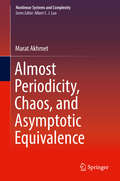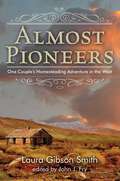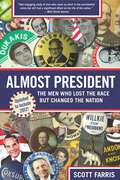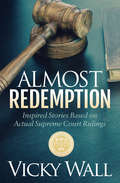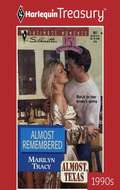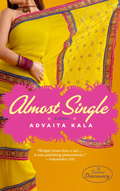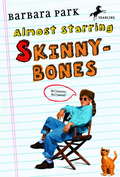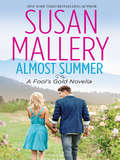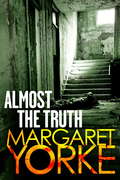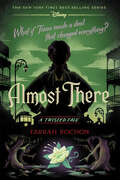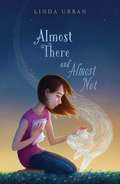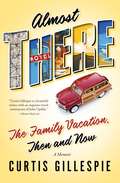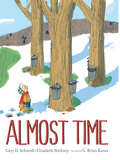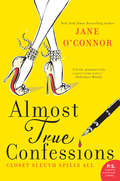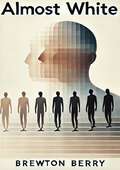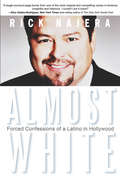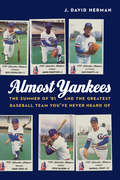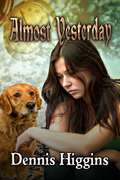- Table View
- List View
Almost Periodicity, Chaos, and Asymptotic Equivalence (Nonlinear Systems and Complexity #27)
by Marat AkhmetThe central subject of this book is Almost Periodic Oscillations, the most common oscillations in applications and the most intricate for mathematical analysis. Prof. Akhmet's lucid and rigorous examination proves these oscillations are a "regular" component of chaotic attractors. The book focuses on almost periodic functions, first of all, as Stable (asymptotically) solutions of differential equations of different types, presumably discontinuous; and, secondly, as non-isolated oscillations in chaotic sets. Finally, the author proves the existence of Almost Periodic Oscillations (asymptotic and bi-asymptotic) by asymptotic equivalence between systems. The book brings readers' attention to contemporary methods for considering oscillations as well as to methods with strong potential for study of chaos in the future. Providing three powerful instruments for mathematical research of oscillations where dynamics are observable and applied, the book is ideal for engineers as well as specialists in electronics, computer sciences, robotics, neural networks, artificial networks, and biology.Distinctively combines results and methods of the theory of differential equations with thorough investigation of chaotic dynamics with almost periodic ingredients;Provides all necessary mathematical basics in their most developed form, negating the need for any additional sources for readers to start work in the area;Presents a unique method of investigation of discontinuous almost periodic solutions in its unified form, employed to differential equations with different types of discontinuity;Develops the equivalence method to its ultimate effective state such that most important theoretical problems and practical applications can be analyzed by the method.
Almost Pioneers: One Couple's Homesteading Adventure in the West
by John FryIn the fall of 1913, Laura and Earle Smith, a young Iowa couple, made the gutsy—some might say foolhardy—decision to homestead in Wyoming. There, they built their first house, a claim shanty half dug out of the ground, hauled every drop of their water from a spring over a half-mile away, and fought off rattlesnakes and boredom on a daily basis. Soon, other families moved to nearby homesteads, and the Smiths built a house closer to those neighbors. The growing community built its first public schoolhouse and celebrated the Fourth of July together—although the festivities were cut short because of snow.By 1917, however, the Smiths had moved back to Iowa, leasing their land to a local rancher and using the proceeds to fund Earle&’s study of law. The Smiths lived in Iowa for most of the rest of their lives, and sometime after the mid-1930s, Laura wrote this clear, vivid, witty, and self-deprecating memoir of their time in Wyoming, a book that captures the pioneer spirit of the era and of the building of community against daunting odds.
Almost President: The Men Who Lost the Race but Changed the Nation
by Scott FarrisVeteran political journalist Scott Farris tells the stories of legendary presidential also-rans, from Henry Clay to Stephen Douglas, from William Jennings Bryan to Thomas Dewey, and from Adlai Stevenson to Al Gore. He also includes concise profiles of every major candidate nominated for president who never reached the White House but who helped promote the success of American democracy. Farris explains how Barry Goldwater achieved the party realignment that had eluded FDR, how George McGovern paved the way for Barack Obama, and how Ross Perot changed the way all presidential candidates campaign. There is Al Smith, the first Catholic nominee for president; and Adlai Stevenson, the candidate of the "eggheads" who remains the beau ideal of a liberal statesman. And Farris explores the potential legacies of recent runners-up John Kerry and John McCain. The book also includes compact and evocative portraits of such men as John C. Fremont, the first Republican Party presidential candidate; and General Winfield Scott, whose loss helped guarantee the Union victory in the Civil War. This new edition of Almost President brings the work up-to-date with a section that explores the results and ramifications of the 2012 presidential election.
Almost Redemption: Inspired Stories Based on Actual Supreme Court Rulings
by Vicky WallA collection of engaging and entertaining stories that give Supreme Court rulings a spiritual and religious twist. The progressive Court has pushed religion out of the marketplace of ideas and traditions to protect small groups of citizens who take offense at religious traditions. These protected classes now define a new American tradition that emphasizes sexual freedoms and that runs counter to the Constitution. By creating laws that appear to enhance the lives of women and men, the judiciary has instead created a spiritual vacuum. Almost Redemption provides readers with compelling stories that are crafted from actual, historically authentic circumstances and that will leave them captivated and engaged. These fictional stories are based on real-life events and are written by an author who knows both the law and literature.
Almost Remembered
by Marilyn TracyALMOST, TEXAS WOMAN WITHOUT A MEMORY There were some things Allison Leary couldn't remember, but her memories of Chas Jamison was clear. His betrayal had been the single biggest hurt in her life. Yet, standing before him after fifteen long years, Allison still ached for his tender touch. And she needed him now more than ever…. Chas couldn't turn his back on Allison. She needed help—and he needed to help her. It was that simple, yet so difficult to do. Because now he wanted to keep her in Almost forever…as his wife! Where a hazard-free happily-ever-after is almost always guaranteed!
Almost Single
by Advaita KalaA bestseller in India and featured in the "Washington Post" and "Los Angeles Times," this debut novel introduces a smart, irreverent young woman searching for independence, love, and matrimony in a society bound by tradition.
Almost Somewhere: Twenty-Eight Days on the John Muir Trail (Outdoor Lives)
by Suzanne RobertsWinner of the National Outdoor Book Award in Outdoor Literature It was 1993, Suzanne Roberts had just finished college, and when her friend suggested they hike California&’s John Muir Trail, the adventure sounded like the perfect distraction from a difficult home life and thoughts about the future. But she never imagined that the twenty-eight-day hike would change her life. Part memoir, part nature writing, part travelogue, Almost Somewhere is Roberts&’s account of that hike. John Muir wrote of the Sierra Nevada as a &“vast range of light,&” and that was exactly what Roberts was looking for. But traveling with two girlfriends, one experienced and unflappable and the other inexperienced and bulimic, she quickly discovered that she needed a new frame of reference. Her story of a month in the backcountry—confronting bears, snowy passes, broken equipment, injuries, and strange men—is as much about finding a woman&’s way into outdoor experience as it is about the natural world Roberts so eloquently describes. Candid and funny, and finally, wise, Almost Somewhere not only tells the whimsical coming-of-age story of a young woman ill-prepared for a month in the mountains but also reflects a distinctly feminine view of nature. This new edition includes an afterword by the author looking back on the ways both she and the John Muir Trail have changed over the past thirty years, as well as book club and classroom discussion questions and photographs from the trip.
Almost Starring Skinnybones
by Barbara ParkAlex "Skinnybones" Frankovitch is about to become a huge star--in his very own TV commercial! But Alex's big plans for stardom go terribly wrong. Are Alex's days as a Big Celebrity over?From the Trade Paperback edition.
Almost Summer
by Susan MalleryEver since she was young, Paige McLean has longed to see the world. Still, she never imagined the world would land on her doorstep in the form of a charming British surgeon who needs a place to stay when his plans fall through.After a devastating loss, Alistair Woodbury has vowed to live his life alone. But in all his travels, he hasn't encountered a town as welcoming as Fool's Gold, nor a woman as caring - or as beautiful - as Paige. Her compassion warms him almost as much as their stolen kisses.When it's Alistair's time to leave, will his brief visit turn into a lifetime stay?A Fool's Gold series novella.
Almost Super (Almost Super Ser. #1)
by Marion JensenPerfect for fans of Pixar's The Incredibles, Almost Super is a fresh, funny middle-grade adventure about two brothers in a family of superheroes who must find a way to be heroic despite receiving powers that are total duds. Filled with humor, heart, and just the right kind of heroics, Almost Super is a winning story that will satisfy would-be heroes and regular kids alike.Everyone over the age of twelve in the Bailey family gets a super power. No one knows why, and no one questions it. All the Baileys know is that it's their duty to protect the world from the evil, supervillainous Johnson family. *shake fists*But when Rafter Bailey and his brother Benny get their superpowers, they're, well . . . super-lame. Rafter can strike matches on polyester, and Benny can turn his innie belly button into an outie. Along with Rafter's algebra class nemesis, Juanita Johnson, Rafter and Benny realize that what they thought they knew about superheroes and supervillains may be all wrong. And it's up to the three of them to put asides their differences and make things right. They may not have great powers, but together, they're almost super.
Almost Ten and a Half (Kobie Book #1)
by Candice F. Ransom[From the back cover:] "Who needs parents? Almost ten-and-a-half year old Kobie Roberts certainly doesn't need parents anymore. If only she were on her own, she could eat whatever she wanted. Stay up late. And never have to do her homework. So when Kobie's mother is in the hospital for a few weeks and a kind, elderly housekeeper named Mrs. Blevins is hired, Kobie figures this is her chance. She wears crazy clothes to school, eats strange breakfasts, and stays up (almost) all night. She even lives under a card-table tent in the living room, and Mrs. Blevens doesn't say a word. But Kobie begins to worry. Maybe with the efficient Mrs. Blevens taking her place, her mother can't come home. Well then, Kobie will just have to drive Mrs. Blevens away--for good!" You never know what to expect from creative, artistic, and strong willed Kobie, but there's bound to be trouble, confusion, laughs and surprises. Look for the other books about her in the bookshare collection including, #2 Going on Twelve, #3 Thirteen, #4 Fourteen and Holding and #5 Fiftteen at Last.
Almost The Only Bridge Book You'll Ever Need: Principles to help you have fun, be more ethical & improve your game.
by Randy BaronThere are many books and articles about how to improve your play, but there are few that focus on being a better partner, having fun and playing bridge the right way. In this book, there is plenty of technical advice. But more important, this book examines the best ways to participate joyfully in the world's greatest game. In this time of various scandals at the highest levels of bridge, these topics need to be promoted more often. Besides, there are thousands of players around the world who have limited awareness that they are making unethical bids, plays or hesitations, or taking advantage of partner's actions. Although you might have come across some of these tips in various books and magazine articles, this book is unique by focusing more on having a pleasant time playing and making your table a welcome and pleasant place to be. What's more important than being a positive role model for everyone around you, getting along with others, and having a good time? You can choose which principles apply to you and your game. Much of what is appropriate for you to improve depends on your personality and how much work you want to put into being a better player, but frequently stressed throughout the book is that you can always be a role model for others. By reading this book and sharing with your partners and friends, we'll all be doing a little more to make the bridge world a friendlier and better environment. Randy's been playing bridge now for about 50 years and worn all hats: expert, author, publisher, editor, columnist, teacher, politician, director, bridge club owner, and lately travel planner. He founded and spent 35 years as president of the world's largest bridge supplier, Baron Barclay Bridge Supplies. The intention of this book is to present a kind of Reader's Digest of essays and tips that can elevate your enjoyment and help you play with impeccable ethics. In Volume 1, Randy gives invaluable advice including: - Useful habits to learn - How to improve your bidding system - Which conventions to play
Almost The Truth
by Margaret YorkeBicklebury is a small village of some three hundred inhabitants, a church and a pub, but no shop, no school, and certainly no crime - until two ex-cons decide it is the ideal location to pull a robbery. Derek Jarvis and his daughter Hannah are home when the two armed men break in, and Derek, fearing for their safety, urges Hannah not to resist. The tactic backfires as one of the men brutally attacks her, leaving her broken and revolted. Derek's marriage and his daughter are never the same again. As his family falls apart, he finds his wife and daughter blame him for what happened, refusing to forgive him even after the men are caught. And so Derek Jarvis, a mild-mannered accountant, conceives a plan to avenge his family. But Derek has never truly looked at himself or anticipated the terrifying twist his quest for revenge may take, as it leads him down the darkest back alleys of the psyche, strips away his controls and confronts his soul with a shocking choice . . .
Almost The Truth
by Margaret YorkeBicklebury is a small village of some three hundred inhabitants, a church and a pub, but no shop, no school, and certainly no crime - until two ex-cons decide it is the ideal location to pull a robbery. Derek Jarvis and his daughter Hannah are home when the two armed men break in, and Derek, fearing for their safety, urges Hannah not to resist. The tactic backfires as one of the men brutally attacks her, leaving her broken and revolted. Derek's marriage and his daughter are never the same again. As his family falls apart, he finds his wife and daughter blame him for what happened, refusing to forgive him even after the men are caught. And so Derek Jarvis, a mild-mannered accountant, conceives a plan to avenge his family. But Derek has never truly looked at himself or anticipated the terrifying twist his quest for revenge may take, as it leads him down the darkest back alleys of the psyche, strips away his controls and confronts his soul with a shocking choice . . .
Almost There (A Twisted Tale #13)
by Farrah RochonThe 13th installment in the New York Times best-selling series asks: What if Tiana made a deal that changed everything? Sometimes life in the Big Easy is tough. No one knows that better than Tiana, though she also believes that hard work can go a long way. But when the notorious Dr. Facilier backs her into a corner, she has no choice but to accept an offer that will alter the course of her life in an instant. Soon Tiana finds herself in a new reality where all her deepest desires are realized: she finally gets her restaurant, her friends are safe and sound, and most miraculous of all, her beloved father is still alive. She's got everything she's ever wanted. . . . But after a while, her hometown grows increasingly eerie, with new threats cropping up in unlikely places. Navigating through this strange new New Orleans, Tiana must work alongside Naveen and Charlotte to set things right—or risk losing everything she holds dear.
Almost There and Almost Not
by Linda UrbanFrom acclaimed author Linda Urban comes the funny, bittersweet story of a girl and her ghosts—and the welcoming home they find where they least expect it. <P><P>California Poppy has been dropped off, yet again, with an unsuspecting relative. This time it’s her eccentric Great-Aunt Monica, a woman she’s never even met. Aunt Monica has no idea what to do with an eleven-year-old, so she puts California to work researching their ancestor, the once-famous etiquette expert Eleanor Fontaine. California soon discovers that Great-Great-Great Aunt Eleanor is...not exactly alive and well, but a ghost—and a super sensitive one at that. The grand dame bursts into clouds of dust whenever she loses her composure, which happens quite often. <P><P>Still, an unexpected four-legged friend and some old-fashioned letter writing make this decidedly strange situation one that California can handle. Just as California’s starting to feel like she’s found a place for herself, life turns upside-down yet again. Thankfully, this time she has some friends almost by her side...
Almost There-A Twisted Tale (A Twisted Tale)
by Farrah RochonThe 13th installment in the New York Times best-selling series asks: What if Tiana made a deal that changed everything? Sometimes life in the Big Easy is tough. No one knows that better than Tiana, though she also believes that hard work can go a long way. But when the notorious Dr. Facilier backs her into a corner, she has no choice but to accept an offer that will alter the course of her life in an instant. Soon Tiana finds herself in a new reality where all her deepest desires are realized: she finally gets her restaurant, her friends are safe and sound, and most miraculous of all, her beloved father is still alive. She's got everything she's ever wanted. . . . But after a while, her hometown grows increasingly eerie, with new threats cropping up in unlikely places. Navigating through this strange new New Orleans, Tiana must work alongside Naveen and Charlotte to set things right—or risk losing everything she holds dear.
Almost There: The Family Vacation, Then and Now
by Curtis GillespieWe all have memories of family vacations: the cross-country marathon drive, the camping trip, a couple lazy weeks at the lake, a helter-skelter month in Europe, four days in Disneyland. The variations may be endless, but the common denominator is that there are always stories to tell. The family vacation, with all its funny, sad, relaxing, stressful, frustrating, and exhilarating moments, shapes us, and helps us create an understanding of who we are and of those we travel with. In his humourous new book, Almost There, award-winning writer Curtis Gillespie explores the meaning of our family vacations, the memories created by them, and how we use these memories to define our relationship with our families and ourselves. Using his own history of family vacations as a backdrop, Gillespie explores how the meaning and symbolism of the family vacation has shifted throughout the decades. For years, families drove across the country or relaxed at a lakeside cottage. Now even the middle-class travel with their nannies or go on a Disney cruise … or take their nannies with them on a Disney cruise. As he sifts through memories and explores family vacation history, Gillespie ultimately discovers that not only is how we choose to vacation an expression of who we are as individual families, but that the very nature of the family vacation reflects, and sometimes even predicts, societal change. The family vacation is something we all share; the laughter, the tears, the moments, the memories. In Almost There, Curtis Gillespie reminds us how important these moments in our lives are, and how important they will continue to be.
Almost Time
by Gary D. Schmidt Elizabeth StickneyA tender father-and-son story about the passage of time, the change of seasons, and the excitement of reaching a goal.Eager for maple syrup, Ethan can&’t wait till sugaring time rolls around. And he can&’t wait till his loose tooth falls out. But his father keeps telling him it&’s not time yet, and no matter how hard he tries, he can&’t make time pass more quickly. The closeness of father and son is evident throughout as they wait and then celebrate the end of waiting. The brief, lyrical text is illuminated by G. Brian Karas&’s beautifully composed, evocative illustrations.
Almost True Confessions
by Jane O'ConnorThis comic mystery set in the elite zip codes of Manhattan will leave you breathless . . . literally What could be more fun for a freelance copy editor than work- ing on a juicy tell-all about one of Manhattan's most enigmatic society doyennes? But when Miranda "Rannie" Bookman arrives at Ret Sullivan's tony Upper East Side apartment, she finds more than the final draft of the reclusive author's manuscript waiting for her—there's also the half-naked body of Ret herself, tied to her bed and strangled with an Hermès scarf. Was this merely a case, as the police believe, of rough sex that got a little too rough? Or was Ret murdered because someone wanted to make absolutely sure she didn't meet her deadline? Once again, Rannie must prove that her mind is just as sharp as her Col-Erase blue pencils—or risk getting rubbed out too.
Almost White
by Brewton BerryAlmost White by Brewton Berry is a compelling exploration of the complex identities and lived experiences of racial and ethnic groups that occupy the ambiguous space between traditional categories of "black" and "white" in the United States. Through meticulous research and vivid storytelling, Berry examines communities such as the Melungeons, the Cajuns, and other historically marginalized groups that defy easy classification, shedding light on their struggles, adaptations, and contributions to American society.Berry delves into the historical, social, and cultural forces that have shaped these groups, addressing the tensions of assimilation, discrimination, and self-identification. He vividly portrays their attempts to navigate a society often defined by rigid racial hierarchies, uncovering the resilience and ingenuity of these communities in the face of exclusion and prejudice.With empathy and academic rigor, Almost White challenges readers to rethink the simplistic binaries of race and ethnicity, offering a nuanced perspective on the fluidity and complexity of identity. By weaving historical analysis with personal stories and field observations, Berry not only provides a deeper understanding of these groups but also prompts broader reflection on the intersections of race, culture, and belonging.This groundbreaking work is essential reading for anyone interested in sociology, anthropology, or American history, as well as those seeking to understand the untold stories of communities often left out of mainstream narratives.
Almost White: Forced Confessions Of A Latino In Hollywood
by Rick NajeraIn Almost White, award-winning writer, actor, director, comedian, playwright, and producer Rick Najera explores what it means to be a Latino against the ever-changing backdrop of his life as a Hollywood creative. A bona fide chameleon, this L.A.-based everyman is "Mexican hyphen American" or, as he wryly puts it, "almost white."Recognized twice as one of the "100 Most Influential Hispanics" by Hispanic Business Magazine, Najera has worked with and mentored some of the biggest stars in Hollywood, including Cheech Marin, Jimmy Smits, Mario Lopez, Sofia Vergara, and many more. His funny, sad, and sometimes dark memoir tells his story of breaking into mainstream Hollywood, what it takes to struggle against typecasting, and how to challenge the pessimistic narrative that Latinos can only be disenfranchised victims in America.Driven by a satirical stream of consciousness, Najera's journey exposes universal lessons, from confronting the limits we place on our imaginations, to the need to take ownership of our stories instead of being mere performers in another's distorted vision, and the necessity of rising every day to press forward-no matter what. "In the end," says Najera, "perhaps it will be the power of the people and art, not politicians and politics, that will redefine the Latino American dream."
Almost Worthy: The Poor, Paupers, and the Science of Charity in America, 1877–1917
by Brent RuswickA history and analysis of scientific charity organizations that arose in late nineteenth century America.In the 1880s, social reform leaders warned that the “unworthy” poor were taking charitable relief intended for the truly deserving. Armed with statistics and confused notions of evolution, these “scientific charity” reformers founded organizations intent on limiting access to relief by the most morally, biologically, and economically unfit. Brent Ruswick examines a prominent national organization for scientific social reform and poor relief in Indianapolis in order to understand how these new theories of poverty gave birth to new programs to assist the poor.“Ruswick’s well-researched monograph traces the history of the charity organization society in the US from its origins in the Gilded Age to its merging with social work in the Progressive Era. . . . Recommended.” —Choice“[This] study provides a welcome insight into the inner workings of charity organization societies and their drive to eliminate poverty.” —Nonprofit & Voluntary Sector Quarterly, Volume43, Issue 4, 2014“Almost Worthy offers a lot of interesting detail pulled from COS case files, professional conference proceedings, journals of the field, and more; some possibly fruitful hypotheses about what to make of changes in COS approaches over time; thoughtful new propositions about the relationship between scientific charity and eugenics (including some charity reformers’ apparent remorse); and a fresh, new mini-biography of Oscar McCulloch interspersed throughout.” —H-SHGAPE“Brent Ruswick wants to put the science back into scientific charity. He argues that the essence of organized charity was not its class prejudices and censorious attitude toward the poor, but rather its belief that systematic evidence-gathering could serve to improve the quality of charity work and public policy.” —American Historical Review, Volume119, Issue 4, October 2014
Almost Yankees: The Summer of '81 and the Greatest Baseball Team You've Never Heard Of
by J. David HermanAlmost Yankees is a poignant and nostalgic narrative of the lives and travails of Minor League Baseball, focusing on the 1981 championship season of the New York Yankees’ Triple-A farm club, the Columbus Clippers. That year was especially notable in the annals of baseball history as the year Major League Baseball went on strike in midseason. When that happened, the Clippers were suddenly the best team in baseball and found themselves the focus of national media attention. Many of these Minor Leaguers sensed this was their last, best chance to make an impression and fulfill their dreams to one day reach the majors. The Clippers’ raw recruits, prospects, and Minor League veterans responded to this opportunity by playing the greatest baseball of their lives on the greatest team most of them would ever belong to. Then the strike ended, leaving them to return to their ordinary aspirational lives and to be just as quickly forgotten.Almost Yankees is the previously untold baseball story of a team and its players performing in the shadow of one of the sport’s most famous teams and infamous owners. Featuring interviews with more than thirty former players (including Steve Balboni, Dave Righetti, Buck Showalter, and Pat Tabler) and dozens of other baseball and media figures, this season’s narrative chronicles success, failure, resilience, and redemption as told by a special group of players with hopes and dreams of big-league glory. J. David Herman, who worshipped the team as an eleven-year-old, tracked down his old heroes to learn their stories—and to better understand his own. The season proved to be a launching pad for some, a final chance for others, and the end of the dream for many others.
Almost Yesterday
by Dennis HigginsBeautiful Cathy Callahan found love at the most unexpected time and place...1906 in San Francisco. It was during the most destructive earthquakes in US history. The trouble is she fell in love a hundred and ten years before she was born. Could her best friend Dawn, keep her from staying in the past? Meet the most powerful time traveler of them all, a lovable Golden Retriever named Hickory Dickory Doc. Discover his unique and surprising origin. Follow the adventures of the Time Pilgrims as they travel to many fascinating times of the past. Go with Katya and Cyrus to England where they investigate the appearance of the Titanic in the Southampton docks, meet the Beatles and experience the London Blitz firsthand. Chase a mysterious man across time with Lesley and Seth as they experience three romantic world's fairs in Chicago--1893, 1933 and 2033. During one, Lesley runs into her teenaged self.
